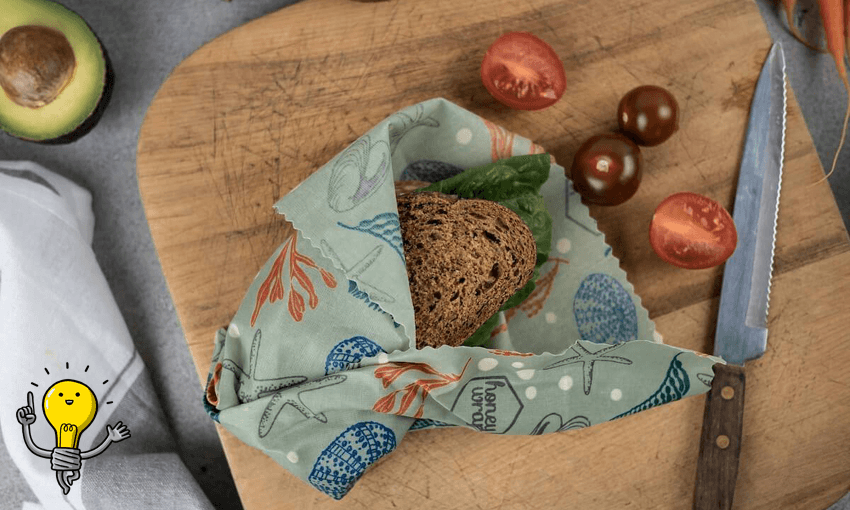In our Q&A series, The Lightbulb, we ask innovators and entrepreneurs to tell us about how they turned their ideas into reality. This week we talk to Honeywrap co-founder Tara McQuinn, makers of organic fabric beeswax wraps.
First of all, give us your elevator pitch for Honeywrap.
Honeywrap is a beeswax wrap made with organic cotton. They’re reusable and an alternative to plastic food wrap like Gladwrap or cling film.
What were you doing prior to Honeywrap?
I was working as an occupational therapist. We (co-founders Jo Falloon and Amy DeMuth) were all occupational therapists. The three of us were all friends and mums.
So what was it that sparked the idea for Honeywrap? What was your lightbulb moment?
I got the idea when my son brought home this beeswax wrapping he’d made for a school project. I thought it was great; it was reusable and it was a good alternative to clingfilm. At the time, no one was making beeswax wrap [commercially in New Zealand], so Jo, Amy and I started researching ingredients to make our own. I was kind of over my job so we were looking at different business ideas we could do together over a glass of wine.
At the time, Jo was on a Plunket committee and they were about to do a market a month later. That kind of gave us a deadline because we thought ‘right, let’s make some to take to the market and sell’. We made them and they ended up selling really well. That was when we realised this really had potential as a business.
We also saw the potential for it to make a difference [to the environment]. It wasn’t just about making another product: we really thought it was something that could help reduce plastic in lunchboxes and just plastic in general as well.
Did you know anything about beeswax wraps before?
Not at all! We’d never seen it. We were kind of just blown away that all the ingredients were natural and how effective it was compared to Gladwrap or cling film. The natural ingredients give the cloth a ‘tackiness’ which allows it to be moulded around your food or dishes, meaning the food gets kept fresher for longer.
What do you use to make Honeywrap?
We use organic cotton, beeswax, tree resin and jojoba oil. We only use organic cotton because we wanted to make sure they weren’t doing harm [to the environment] by using normal cotton which was full of pesticides. The other ingredients are natural preservatives so the wrap becomes more pliable but also more tolerant of the fridge or freezer.
All our beeswax comes from New Zealand Beeswax down in Geraldine. We used to just get it from friends who had beehives and we’d sieve all the wax out ourselves. But the quality of beeswax was so variable between beehives [that it was difficult] to get the product to have the same end finish. So now we get all our beeswax from a single supplier.
We also used to make all our wraps in the garden shed at the back of our house. But about a month ago, we finally moved into our new premises [in Avondale]. It’s got an office area and a production area so we’ve got more room for production.
What’s been your biggest challenge so far?
Probably the need for really good production. We don’t just have a product we can market and sell, so we’ve really got to manage the production side of the business. And because all the ingredients are natural, they can be quite variable too. They respond to heat differently, they respond to waxes differently. Figuring out questions like how to cut the fabric to maximise the number of pieces that we get have been challenging too.
Because we’ve been based from home, it’s always been about having enough people to scale. But I think we’re finally at the point now where we’ve made enough product… to actually keep up with demand.
Now the challenge is making sure we stand out from the rest since there’s way more competition out there now.
What about in terms of trying to get the formula just right? That must’ve also been quite challenging at the start.
When we were first trying to make the mix, it was like being back at school again doing science experiments. My whole kitchen was just covered with different swatches of different mixes. We were trying to make them on the stove, testing and retesting them.
It ended up taking about six months for us to try and come up with the best ratio that actually worked.
What stage of business is Honeywrap currently at? Is the business profitable?
We’re just about profitable, but I’d say we’re still at a growth stage. We definitely wouldn’t still be doing this if we weren’t making a profit!
Finally, what can we expect for the rest of 2019?
For Plastic Free July, we’re collaborating with Project Jonah so that all the profits we make from the new Moana print (by Wellington artist Cat McKay) will go to support their work in protecting our marine life.
We’ve also got some other new prints coming out including another new design from Evie Kemp. And then we’ve got a couple of other products we’re making as well to help people reduce plastic in the kitchen.
